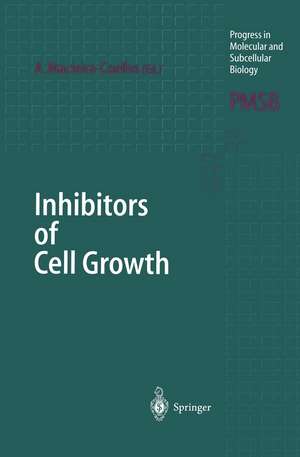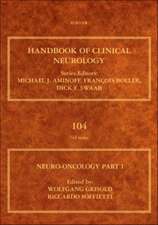Inhibitors of Cell Growth: Progress in Molecular and Subcellular Biology, cartea 20
Editat de Alvaro Macieira-Coelhoen Limba Engleză Paperback – 13 iun 2012
Din seria Progress in Molecular and Subcellular Biology
- 18%
 Preț: 1115.46 lei
Preț: 1115.46 lei - 18%
 Preț: 1403.04 lei
Preț: 1403.04 lei - 18%
 Preț: 1112.30 lei
Preț: 1112.30 lei - 18%
 Preț: 1117.03 lei
Preț: 1117.03 lei - 18%
 Preț: 1222.49 lei
Preț: 1222.49 lei - 18%
 Preț: 1382.21 lei
Preț: 1382.21 lei - 18%
 Preț: 1232.26 lei
Preț: 1232.26 lei - 18%
 Preț: 1222.80 lei
Preț: 1222.80 lei - 24%
 Preț: 1045.93 lei
Preț: 1045.93 lei - 18%
 Preț: 956.50 lei
Preț: 956.50 lei -
 Preț: 387.20 lei
Preț: 387.20 lei - 15%
 Preț: 639.73 lei
Preț: 639.73 lei - 15%
 Preț: 633.19 lei
Preț: 633.19 lei - 15%
 Preț: 634.18 lei
Preț: 634.18 lei - 15%
 Preț: 634.00 lei
Preț: 634.00 lei - 15%
 Preț: 640.24 lei
Preț: 640.24 lei - 5%
 Preț: 714.27 lei
Preț: 714.27 lei - 15%
 Preț: 634.32 lei
Preț: 634.32 lei - 15%
 Preț: 637.28 lei
Preț: 637.28 lei - 15%
 Preț: 637.78 lei
Preț: 637.78 lei - 15%
 Preț: 637.28 lei
Preț: 637.28 lei - 15%
 Preț: 649.06 lei
Preț: 649.06 lei - 18%
 Preț: 1220.75 lei
Preț: 1220.75 lei - 18%
 Preț: 1224.99 lei
Preț: 1224.99 lei - 18%
 Preț: 946.87 lei
Preț: 946.87 lei - 15%
 Preț: 633.35 lei
Preț: 633.35 lei - 18%
 Preț: 944.36 lei
Preț: 944.36 lei -
 Preț: 387.96 lei
Preț: 387.96 lei - 15%
 Preț: 633.02 lei
Preț: 633.02 lei - 15%
 Preț: 640.88 lei
Preț: 640.88 lei - 5%
 Preț: 720.10 lei
Preț: 720.10 lei
Preț: 387.75 lei
Nou
Puncte Express: 582
Preț estimativ în valută:
74.22€ • 80.65$ • 62.38£
74.22€ • 80.65$ • 62.38£
Carte tipărită la comandă
Livrare economică 21 aprilie-05 mai
Preluare comenzi: 021 569.72.76
Specificații
ISBN-13: 9783642721519
ISBN-10: 3642721516
Pagini: 288
Ilustrații: XII, 272 p. 17 illus.
Dimensiuni: 155 x 235 x 22 mm
Greutate: 0.41 kg
Ediția:Softcover reprint of the original 1st ed. 1998
Editura: Springer Berlin, Heidelberg
Colecția Springer
Seria Progress in Molecular and Subcellular Biology
Locul publicării:Berlin, Heidelberg, Germany
ISBN-10: 3642721516
Pagini: 288
Ilustrații: XII, 272 p. 17 illus.
Dimensiuni: 155 x 235 x 22 mm
Greutate: 0.41 kg
Ediția:Softcover reprint of the original 1st ed. 1998
Editura: Springer Berlin, Heidelberg
Colecția Springer
Seria Progress in Molecular and Subcellular Biology
Locul publicării:Berlin, Heidelberg, Germany
Public țintă
ResearchCuprins
References.- The Growth-Inhibitory Effects of TGF?.- 1 Introduction.- 2 The Eukaryotic Cell Cycle.- 3 Effects of TGF? on Cell-Cycle Progression.- 4 Conclusions.- References.- Big Brothers Are Watching: the Retinoblastoma Family and Growth Control.- 1 Introduction.- 2 Interaction of Retinoblastoma Family Proteins with the Transcription Factor E2F.- 3 Structure and Expression of Retinoblastoma Family Members.- 4 Growth Inhibition by Retinoblastoma Family Members.- 5 Effects of Deletions of RB Family Members on Mice Development.- 6 Regulation of RB Family Members by Cyclin/CDK complexes — the Restriction Point.- 7 Role of pRB in Growth-Promoting Pathways.- 8 Role of pRB in Growth-Inhibiting Pathways; Apoptosis and Differentiation.- 9 RB2/130 and p107 Confer a Growth Suppressive Ability, Other than pRB.- 10 pRB Inhibits Biosynthesis Via Inhibiting RNA pol I and pol III-Dependent Transcription.- 11 RB Family Members Interact with Several Other Growth-Regulating Genes.- 12 Concluding Remarks.- References.- The Growth-Regulatory Role of p21(WAF1/CIP1).- 1 Introduction.- 2 p21-Induced Growth Arrest Is Mediated Through Protein-Protein Interactions.- 3 p21 Expression During Development and Differentiation.- 4 Growth Suppression by p21.- 5 p21 Expression and Apoptosis.- 6 Regulation of p21 Expression.- 7 p21 and Transcriptional Activation of Downstream Genes.- 8 p21 and Cancer.- References.- Mechanisms of Cell Cycle Blocks at the G2/M Transition and Their Role in Differentiation and Development.- 1 Introduction.- 2 Cdk Kinases and Cell-Cycle Control.- 3 Basic Controls of Cdc2 Kinase Activity.- 4 Mechanisms of Negative Control at G2/M.- 5 Oncogenes and Tumor-Suppressor Genes in G2 Arrest.- 6 G2/M Blocks in Meiosis.- 7 G2 Blocks During Development.- 8 G2 Blocks inDifferentiation.- References.- Mechanisms of Interferon Action.- 1 Introduction.- 2 The Interferon Proteins and Genes.- 3 The Interferon Receptors.- 4 IFN-Dependent Signaling Pathways.- 5 IFN-stimulated Genes.- 6 Therapeutic Potentials of the IFNs.- 7 Interferons as Hormones of Pregnancy.- 8 Conclusion.- References.- Growth-Inhibiting N-Substituted Endogenous Peptides.- 1 Introduction.- 2 Purification and Characterization of Endogenous Growth Inhibitors.- 3 Other N-Substituted Inhibitory Oligopeptides.- 4 N-Substituted Inhibitory Oligopeptides in Neoplasia.- 5 Purification Procedures Used for Characterization of N-Substituted Peptides.- 6 „Chalones“ and Inhibitory N-Substituted Oligopeptides: Similarities and Differences.- 7 Possible Strategies for Clinical Use of Endogenous Growth Inhibitors.- 8 Concluding Remarks.- References.- Endogenous Angiogenesis Inhibitors: Angiostatin, Endostatin, and Other Proteolytic Fragments.- 1 Introduction.- 2 Angiostatin.- 3 Endostatin.- 4 Other Angiogenesis Inhibitors.- 5 Clinical Applications.- References.- Inhibitors of Preadipocyte Replication: Opportunities for the Treatment of Obesity.- 1 Introduction.- 2 Preadipocytes.- 3 Relationship Between Host Characteristics and Adipose Cell Dynamics.- 4 Control of Preadipocyte Replication.- 5 Potential Therapeutic Strategies.- References.- Growth Inhibitors for Mammary Epithelial Cells.- 1 Introduction.- 2 The Role of Transforming Growth Factor-? (TGF-?) in Mammary Gland Development.- 3 Mammary-Derived Growth Inhibitor (MDGI).- 4 Tumor Necrosis Factor Alpha (TNF-?).- 5 Conclusion.- References.- Growth Inhibition of Human Fibroblasts in Vitro.- 1 Introduction.- 2 Mechanisms Responsible for Contact Inhibition of Growth.- 3 Mechanisms Responsible for the Terminal Postmitotic Stage ofHuman Fibroblasts.- References.
Caracteristici
This book covers the whole range of inhibitors of cell growth, and considers therapeutic applications, development and structure-function relationships.









